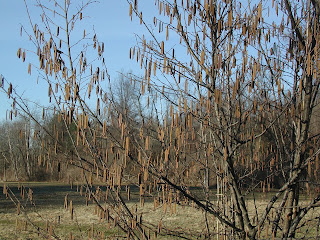 Winter cold is all too evident, right now. Or maybe it’s just that spring is later than usual. Here it is, the first week in April, and cornelian cherries (Cornus mas) have yet to bloom. Yet one reason I grow this tree is because its blossoms are among the first to awaken in spring. The stems are typically drenched in a profusion of small, yellow flowers in early spring, just after the middle of March, and blossoming goes on and on for weeks.
Winter cold is all too evident, right now. Or maybe it’s just that spring is later than usual. Here it is, the first week in April, and cornelian cherries (Cornus mas) have yet to bloom. Yet one reason I grow this tree is because its blossoms are among the first to awaken in spring. The stems are typically drenched in a profusion of small, yellow flowers in early spring, just after the middle of March, and blossoming goes on and on for weeks.
Everyone else is blossoming on time. Witchhazel has been in bloom for a few weeks, hellebores have opened, and buds seem ready and on time on forsythia, lilacs, and clove currants.
Cornelian cherry blossoms might have been killed by winter cold, although they’ve survived colder winters in the past. Teasing open one of the fat flower buds reveals the makings of yellow flowers, so perhaps they are just late this year.
I hope the flowers are merely still resting because, if so, they will be followed by fruits that look and taste like tart cherries. Like the flowers, they’re also borne in profusion, and decoratively hang from the branches for a long time unless harvested. Unlike tart cherries, cornelian cherries fruit very reliably with little bother from any pests.
--------------------------------------------------
Other evidence of this past winter’s cold – unrelated to the lateness, or not, of spring – is bamboo. Today was overcast and rainy, and driving back from having my truck inspected, I couldn’t help but note patches of winterkilled bamboo in various yards. The clumps of upright stalks draped with now-tawny leaves, very attractive as a muted prelude to the exuberance of spring blossoms, really jump out in the landscape once you start looking.
Soon bamboo will shed its dead leaves and become unattractive, a brief phase that ends as soon as new shoots poke through the ground. They grow very quickly – I’ve measured 6 inches a day of growth – and are quickly clothed in fresh, green leaves.
---------------------------------------------
Particularly welcome and, I think, on time are some blossoms that are not even colorful. Those blossoms are the catkins on my filbert bushes. They are brown but drape decoratively down from the branches like the tails of cats (actually kittens, the origin of the word from the old Dutch word katteken).
Catkins are spikes of flowers, all male in the case of filberts. The female flowers are hardly noticeable until they start developing into clusters of nuts.
My filberts are European hybrids, the nuts of which are large and tasty. Years ago I grew some native filberts (Corylus americana), which bear nuts that are really too small and not tasty enough to be worth eating. The reason I planted them was because they are resistant to filbert blight disease, a disease indigenous in eastern U.S.. European filberts (C. avellana) are grown commercially in the U.S. in the Pacific northwest, where the disease was absent.
Note the phrase “was absent.” Filbert blight started showing up in those parts in the 1980s so breeders there started looking for and developing resistant varieties of European filberts. Actually, some eastern filbert enthusiasts had bred some fairly resistant varieties, such as Graham Hybrid, Gellatly, and Hall’s Giant, all of which I planted almost 15 years ago. They bore well but got some blight. The breeders in Oregon came up with some new varieties that are immune to the blight.
Long story short: I’ve been enjoying large, tasty filbert nuts in autumn and the-catkin draped branches early each spring for a number of years. The varieties I now have are Lewis, Clark, Yamhill, Jefferson, and Santiam. That’s a lot of nuts!
--------------------------------------------
More nuts. Hickories are delicious (a close relative of pecans) but a hard nut to crack and, once cracked, yield little nutmeat. I recently read an article about improved varieties of this native tree, varieties whose nutmeat crack out in halves. I just ordered trees of the varieties Selbher and Henning.
----------------------------------------------------




No comments:
Post a Comment